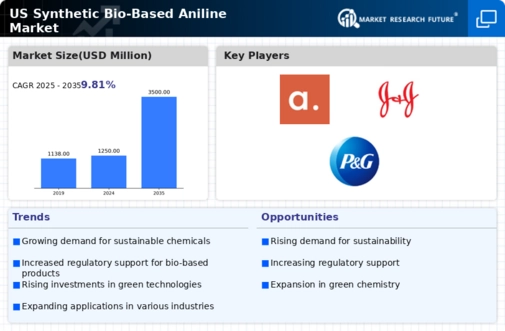The synthetic bio-based-aniline market is currently characterized by a dynamic competitive landscape, driven by increasing demand for sustainable chemical solutions and stringent environmental regulations. Key players such as BASF SE (Germany), Huntsman Corporation (US), and Covestro AG (Germany) are actively positioning themselves through innovation and strategic partnerships. BASF SE (Germany) emphasizes its commitment to sustainability by investing in bio-based feedstocks, while Huntsman Corporation (US) focuses on expanding its product portfolio to include eco-friendly alternatives. Covestro AG (Germany) is also enhancing its operational focus on circular economy principles, which collectively shapes a competitive environment that prioritizes sustainability and innovation.
In terms of business tactics, companies are increasingly localizing manufacturing to reduce supply chain vulnerabilities and optimize logistics. The market structure appears moderately fragmented, with several players vying for market share. However, the collective influence of major companies like BASF SE (Germany) and Huntsman Corporation (US) suggests a trend towards consolidation, as these firms leverage their resources to enhance competitive positioning.
In October 2025, BASF SE (Germany) announced a partnership with a leading biotechnology firm to develop a new bio-based aniline production process. This strategic move is likely to enhance BASF's sustainability credentials and expand its product offerings, aligning with the growing market demand for environmentally friendly chemicals. The collaboration may also facilitate access to innovative technologies that could streamline production processes.
In September 2025, Huntsman Corporation (US) launched a new line of bio-based aniline derivatives aimed at the textile industry. This initiative reflects Huntsman's strategy to diversify its product range while addressing the increasing consumer preference for sustainable materials. The introduction of these derivatives could potentially strengthen Huntsman's market position and attract environmentally conscious customers.
In August 2025, Covestro AG (Germany) unveiled a new facility dedicated to the production of bio-based aniline, which is expected to significantly increase its production capacity. This expansion not only demonstrates Covestro's commitment to meeting rising demand but also positions the company as a leader in sustainable chemical manufacturing. The facility is anticipated to enhance operational efficiency and reduce carbon emissions, aligning with global sustainability goals.
As of November 2025, current competitive trends in the synthetic bio-based-aniline market indicate a strong emphasis on digitalization, sustainability, and the integration of advanced technologies such as AI. Strategic alliances are increasingly shaping the landscape, enabling companies to pool resources and expertise. Looking ahead, competitive differentiation is likely to evolve from traditional price-based competition to a focus on innovation, technological advancements, and supply chain reliability. This shift underscores the importance of sustainability and efficiency in maintaining a competitive edge in the market.














Leave a Comment